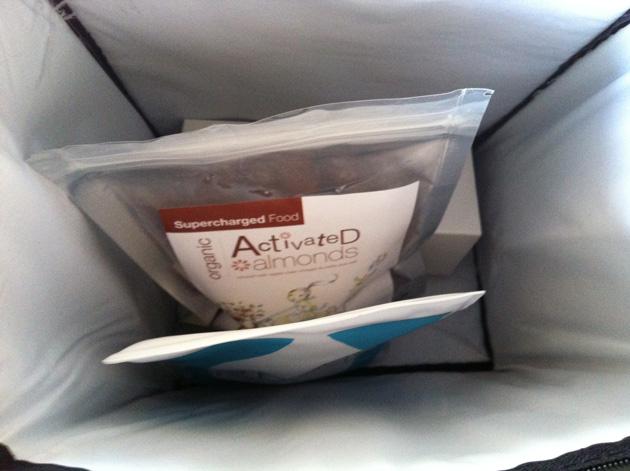
Earlier this week, celebrity chef and haute snacker Pete Evans activated a social media frenzy after he disclosed the minutiae of his highly-regimented day on a plate to the aptly-named Sunday Life culinary circle jerk column, My Day On A Plate. Along with a penchant for alkalised water, spirulina, maca, cultured vegetables (as opposed to philistine vegetables, they’re the worst) and emu meatballs, Evans displayed an unusual fondness for activated almonds that inspired both the nation’s ravenous appetite for Twitter blood and piqued our interest as to what the fuck an activated almond actually is.
Ever the intrepid eaters of free food, booze and cult-status detox products, we took it upon ourselves to deactivate the furore and demystify the myth surrounding the nation’s favourite edible meme by conducting a highly-scientific product road test of activated almonds. Here’s what we’ve discovered:
Our activated almonds came courtesy of Urban Remedy and Supercharged Foods, who also plied us with a three day juice cleanse last year. The nuts form part of both an insanely balanced diet of douchebaggery and are an integral part of a delicious Cleansing Extras Menu designed to supplement said cleanse that also includes bite-size nuggets of ambiguous deliciousness called AMAZEballs. I kid you not. They are kind of “amazeballs” too, and as someone who has made that word my sworn enemy in this life using it is no small feat of praise. I would eat them for both breakfast and dessert. Amazeballs come in three flavours: chocolate, green (which I think is short for ‘green tea’) and almond. We doubled down and went with almond flavoured balls, because of obvious reasons and the fact that chocolate flavoured balls are so 1998.

First, some background information on what exactly constitutes an almond that has been activated, according to the back of the packet. The almonds are soaked for 12 hours in filtered water (that I think is alkalised with ‘organic apple cider vinegar’), which then allows the enzymes to neutralise phytic acid and break down complex starch, making them easier to digest. Translation: it makes them soft and digestible. Also making things easier to digest since the dawn of time: teeth.
The almonds are then dehydrated at 49 degrees celsius for 6 hours and this results in “a nutrient-dense, enzyme-rich, raw snack”. At this point I already had a few questions, like: isn’t subjecting food to a heat above room temperature for a controlled period of time the very definition of cooking? And the longer you cook something the less nutrients it retains, right? So how then are these almonds still classified as raw and yet somehow made more dense in nutrient value through a process that sounds suspiciously like cooking? Who knows? Pete probably. They even come in a temperature controlled esky bag with a cold pack, because of science.

Anyway, they’re infused with Celtic sea salt (because it’s braver than regular Australian sea salt) and are supposed to boost your metabolism and immune system’s ability to function. Excellent. So now that’s sorted and we know what constitutes the activating of an almond, let’s eat.

You might find it hard to believe – I know I did – but activated almonds taste just like regular toasted almonds that have encountered salt and heat. They’re delicious, crunchy, a bit salty and sometimes you get a really foul dud – just like regular almonds. Full disclosure: I eat all the almonds every day, and regularly add things like chia seeds, linseeds and quinoa to everything, so by no means am I discrediting the addition of extraneous nutrients and supplements that verge on – and exceed – a point of obnoxiousness that is regularly made apparent to me. Because I’m so obnoxious, I made everyone present in the office eat an activated almond and give a facially registered review of their findings:




As you can probably deduce from this highly scientific – and journalistic – enquiry, using unbiased empirical evidence like gut reactions measured in units of face scrunchedness, activated almonds illicit a response not dissimilar from ‘meh‘. They’re pretty hit and miss – mostly crunchy, some sweeter than others, and they lack the sometimes cloying texture of a regular almond’s skin that can get stuck to your teeth. So annoying, right? There is, however, a huge difference in appearance.

Just kidding. All up, activated almonds have done absolutely nothing to assist me with the slight hangovers I’ve had over the past couple of days and taste just like regular almonds. I managed to draw out one packet of almonds to snack on over three days and I don’t feel any more activated than I did before (probably because of the hangovers). In short, they’re nice in a salted toasted almond kinda way, but they probably won’t change your life.
Like Sunday Life nutritionist Dr Joanna McMillan suggested, with activated almonds you’ll get “top marks for effort but [because] there is no scientific evidence behind things like activated almonds” you’ll just end up looking like a cultured vegetable of a chef whose legacy as a successful restauranteur has been succeeded by his reputation as an excessively smug hashtag.



